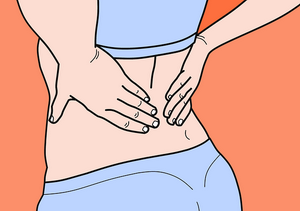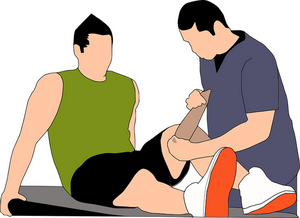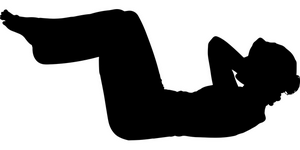 This seemingly simple little question is almost always answered wrong. Just how much should you do anything? For me, this came into sharp awareness recently while working with my sweetie Ellen while her back was seized up for a week. Essential to recovering from a seized up back is movement. Movement hurts so her natural response was to freeze and not move at all. Unfortunately, our natural response to avoid pain is often a terrible thing to do. Without movement, there is little to no exchange of fluids in the inflamed area. Those fluids are necessary to carry away the noxious chemicals released by the inflammation and to bring in nutrition and oxygen to support healing. But it hurts to move. The question is how much movement is the right amount to promote healing but not increase the damage or inflammation?
This seemingly simple little question is almost always answered wrong. Just how much should you do anything? For me, this came into sharp awareness recently while working with my sweetie Ellen while her back was seized up for a week. Essential to recovering from a seized up back is movement. Movement hurts so her natural response was to freeze and not move at all. Unfortunately, our natural response to avoid pain is often a terrible thing to do. Without movement, there is little to no exchange of fluids in the inflamed area. Those fluids are necessary to carry away the noxious chemicals released by the inflammation and to bring in nutrition and oxygen to support healing. But it hurts to move. The question is how much movement is the right amount to promote healing but not increase the damage or inflammation?
 This question of “how much” applies to all sorts of activities in our lives. Let’s address Ellen’s concern first. The key concept is about how to move into the edge of pain without actually promoting overt pain. The challenge is to be willing to feel the pain. Most people only want the pain to just go away. They don’t want to feel any pain at all. This is a bad idea. We have a finely tuned pain-reporting system for a reason. Pain nerves are not put there just to make us suffer. They are there to help us survive and to guide us in our recovery from injuries. When you pay attention to the pain you notice that pain is not just on or off. Pain intensity varies. Why do you think we were set up that way? Why would we be designed to be aware of little bits of pain? What would be the advantage of having mild to moderate pain? Why not just have things set up with either all good or all bad?
This question of “how much” applies to all sorts of activities in our lives. Let’s address Ellen’s concern first. The key concept is about how to move into the edge of pain without actually promoting overt pain. The challenge is to be willing to feel the pain. Most people only want the pain to just go away. They don’t want to feel any pain at all. This is a bad idea. We have a finely tuned pain-reporting system for a reason. Pain nerves are not put there just to make us suffer. They are there to help us survive and to guide us in our recovery from injuries. When you pay attention to the pain you notice that pain is not just on or off. Pain intensity varies. Why do you think we were set up that way? Why would we be designed to be aware of little bits of pain? What would be the advantage of having mild to moderate pain? Why not just have things set up with either all good or all bad?
 The answer to this is simple. Most of the things that advance us or improve our life involve enduring discomfort. If we totally avoided pain or discomfort, we would never leave our baby cribs. Everything productive in life involves risk, and risk involves occasional pain. Pain is there to let us know when we are pushing ourselves into stress and strain. Too much stress and strain results in injury, something we definitely want to avoid. But some stress and strain can be sustained in order to reach the goals we desire. By having a system that gradually tells us about the consequence of that stress in the form of a simple message like pain, we are easily able to assess when we are reaching the point of injury. Gradually increasing levels of pain enable us to make choices about what price we want to pay in order to achieve our goals. We experience the consequences of minor injuries and learn what those feel like as they happen. We also get to experience what kind of pain is associated with an acute serious injury. Often folks are quite willing to experience mild injuries in order to reach goals – just look at the level of pain experienced by professional athletes or dancers. For that matter, look at the pain experienced by folks working from home hunched over their laptop. For the gaining of the almighty dollar, we are willing to experience all sorts of pain. But we need to be able to make the decision about just how much personal damage we are willing to take on in order to get what we want. It is our variable pain levels that allow us to make this decision.
The answer to this is simple. Most of the things that advance us or improve our life involve enduring discomfort. If we totally avoided pain or discomfort, we would never leave our baby cribs. Everything productive in life involves risk, and risk involves occasional pain. Pain is there to let us know when we are pushing ourselves into stress and strain. Too much stress and strain results in injury, something we definitely want to avoid. But some stress and strain can be sustained in order to reach the goals we desire. By having a system that gradually tells us about the consequence of that stress in the form of a simple message like pain, we are easily able to assess when we are reaching the point of injury. Gradually increasing levels of pain enable us to make choices about what price we want to pay in order to achieve our goals. We experience the consequences of minor injuries and learn what those feel like as they happen. We also get to experience what kind of pain is associated with an acute serious injury. Often folks are quite willing to experience mild injuries in order to reach goals – just look at the level of pain experienced by professional athletes or dancers. For that matter, look at the pain experienced by folks working from home hunched over their laptop. For the gaining of the almighty dollar, we are willing to experience all sorts of pain. But we need to be able to make the decision about just how much personal damage we are willing to take on in order to get what we want. It is our variable pain levels that allow us to make this decision.
 This brings us to Ellen’s situation with her back – just how much movement is right? Her back spasm was greatly amplified by a home physical therapist doing an evaluation on her. He had his list of movements he wanted to see her do and insisted she try to do them, even though she told him her back was already hurting. She did what he insisted and shortly after this she went into full-back seize. Obviously from my perspective, this was too much movement. It was not right. I see this problem all the time. Patients bring me in their list of exercises their medical doctor or hospital gave them. It basically shows them a picture of various movements and says to do some number of these movements so many times. To me this is absurd. Even a well-trained athlete’s ability to perform a given exercise may vary as much as 50% from one day to the next. We are not machines. A lot of stuff goes on inside us that varies our strength and endurance from day to day.
This brings us to Ellen’s situation with her back – just how much movement is right? Her back spasm was greatly amplified by a home physical therapist doing an evaluation on her. He had his list of movements he wanted to see her do and insisted she try to do them, even though she told him her back was already hurting. She did what he insisted and shortly after this she went into full-back seize. Obviously from my perspective, this was too much movement. It was not right. I see this problem all the time. Patients bring me in their list of exercises their medical doctor or hospital gave them. It basically shows them a picture of various movements and says to do some number of these movements so many times. To me this is absurd. Even a well-trained athlete’s ability to perform a given exercise may vary as much as 50% from one day to the next. We are not machines. A lot of stuff goes on inside us that varies our strength and endurance from day to day.
 So what does make sense? Well, we have a built-in pain system that is perfectly designed to give us the feedback we need to tell us exactly what we need to do. The key is, just as I said earlier, about how to move into the edge of pain without actually promoting overt pain. This is where healing and recovery live. It is also where strength and endurance building lives. When we do little or nothing, nothing gets better. When we do too much we get even worse. We need to do that in-between movement. And the only way to know where that place is is through feeling that edge of pain. You can’t follow a prescription of a certain number of reps for so many sets. We just are not built to work that way. The right amount is the right amount, and that amount is whatever is needed to produce a little bit of pain or discomfort but not a lot. Just how much pain is right will depend upon your goal. If you are recovering from post-surgical adhesions following a knee replacement, quite a bit of pain endurance is needed to break up those adhesions. If your goal is to simply maintain muscle tone, then only mild pain is needed to signal you when the right amount of work/stretch/exercise has been reached.
So what does make sense? Well, we have a built-in pain system that is perfectly designed to give us the feedback we need to tell us exactly what we need to do. The key is, just as I said earlier, about how to move into the edge of pain without actually promoting overt pain. This is where healing and recovery live. It is also where strength and endurance building lives. When we do little or nothing, nothing gets better. When we do too much we get even worse. We need to do that in-between movement. And the only way to know where that place is is through feeling that edge of pain. You can’t follow a prescription of a certain number of reps for so many sets. We just are not built to work that way. The right amount is the right amount, and that amount is whatever is needed to produce a little bit of pain or discomfort but not a lot. Just how much pain is right will depend upon your goal. If you are recovering from post-surgical adhesions following a knee replacement, quite a bit of pain endurance is needed to break up those adhesions. If your goal is to simply maintain muscle tone, then only mild pain is needed to signal you when the right amount of work/stretch/exercise has been reached.
 How do you know if the right amount of discomfort is indeed the right amount? The answer is by looking at the feedback of whether you are reaching your goal. How much hunger do you have to put up with to lose that 20 pounds you want to get rid of? Check the scale. Is that 20 pounds coming off? Are your squat exercises doing enough to enable you to get up out of a chair easily? If not, then you need to do either more of them or do them more slowly. Naturally, this will produce more discomfort than before, but that is the feedback about just how far into the discomfort zone you need to go to get the results you want. This needs to be counterbalanced with another feeling awareness – how long does the discomfort persist? If something is uncomfortable, even a lot uncomfortable, but the discomfort goes away in a few minutes, then it is unlikely to be causing any injury. That makes it an okay discomfort for your body to endure. But if you do an exercise that hurts and still hurts two days later, then that was too much and you induced some level of injury.
How do you know if the right amount of discomfort is indeed the right amount? The answer is by looking at the feedback of whether you are reaching your goal. How much hunger do you have to put up with to lose that 20 pounds you want to get rid of? Check the scale. Is that 20 pounds coming off? Are your squat exercises doing enough to enable you to get up out of a chair easily? If not, then you need to do either more of them or do them more slowly. Naturally, this will produce more discomfort than before, but that is the feedback about just how far into the discomfort zone you need to go to get the results you want. This needs to be counterbalanced with another feeling awareness – how long does the discomfort persist? If something is uncomfortable, even a lot uncomfortable, but the discomfort goes away in a few minutes, then it is unlikely to be causing any injury. That makes it an okay discomfort for your body to endure. But if you do an exercise that hurts and still hurts two days later, then that was too much and you induced some level of injury.
 So, now you have two kinds of pain feedback with which to guide you in your exercise rehab or maintenance – the level of moving into pain during the activity and the degree of persistence of the pain after you are finished. Both of these will vary from day to day depending on how well you rested the night before, what you ate in the 24 hours before the exercise, how stressed you are, what mood you are in, and so on. As you can now see, rigid exercise schedules of a certain number of sets and reps are a dumb and inefficient way to go. As humans, we are all across the board with our abilities over time. Our best tool for assessing our optimal level of engagement is our level of pain and discomfort. But to use this highly useful tool, we have to be willing to carefully listen to that pain and not try to avoid it. Obviously, if we are hopped up on pain killers, our pain feedback will not be accurate and we could easily injure ourselves. This is a constant choice professional contact sport players make when they get injured on the field. Do they sit the rest of the game out because they hurt, or do they dose up on pain pills or inject the injured area with pain killers in order to finish out the game? The stakes are a bit higher for them and they might make different choices than would be wise for us.
So, now you have two kinds of pain feedback with which to guide you in your exercise rehab or maintenance – the level of moving into pain during the activity and the degree of persistence of the pain after you are finished. Both of these will vary from day to day depending on how well you rested the night before, what you ate in the 24 hours before the exercise, how stressed you are, what mood you are in, and so on. As you can now see, rigid exercise schedules of a certain number of sets and reps are a dumb and inefficient way to go. As humans, we are all across the board with our abilities over time. Our best tool for assessing our optimal level of engagement is our level of pain and discomfort. But to use this highly useful tool, we have to be willing to carefully listen to that pain and not try to avoid it. Obviously, if we are hopped up on pain killers, our pain feedback will not be accurate and we could easily injure ourselves. This is a constant choice professional contact sport players make when they get injured on the field. Do they sit the rest of the game out because they hurt, or do they dose up on pain pills or inject the injured area with pain killers in order to finish out the game? The stakes are a bit higher for them and they might make different choices than would be wise for us.
 So with Ellen, I had her start to do knee bends toward the chest up to slight discomfort, then with the knees bent contract her butt muscles to start to raise her hips – again just till there was slight discomfort. A similar strategy was used for side-to-side knee motion. She found that the discomfort persisted for about an hour after she finished, then was okay. I had her repeat this several times during the day. This movement allows for fluid exchange in the spastic muscles and joints to help with their healing. It was a great revelation to her to realize that she could be okay with a little bit of pain and use it to her advantage instead of just avoiding pain as she had been doing. You can use this as well.
So with Ellen, I had her start to do knee bends toward the chest up to slight discomfort, then with the knees bent contract her butt muscles to start to raise her hips – again just till there was slight discomfort. A similar strategy was used for side-to-side knee motion. She found that the discomfort persisted for about an hour after she finished, then was okay. I had her repeat this several times during the day. This movement allows for fluid exchange in the spastic muscles and joints to help with their healing. It was a great revelation to her to realize that she could be okay with a little bit of pain and use it to her advantage instead of just avoiding pain as she had been doing. You can use this as well.
Take care,
David
